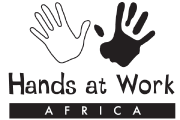OUR MODEL
THE CRISIS
Institutional Response Overwhelmed
In Africa’s poorest villages, HIV/AIDS, orphaned children and poverty are at overwhelming levels and support structures are very low. Institutional models of care, such as hospitals and orphanages, are overwhelmed and unable to cope with the sheer volume of needed care.
A child carrying her sibling and visiting her sick mother in a clinic near Kabwe, Zambia.
“The magnitude of orphans due to HIV/AIDS is so large that an institutional response — besides not being in the best interests of the child — will never be the answer. Orphanages for more than 14 million orphans simply cannot be built and sustained.”
The Most Vulnerable
In 2005 an influential South African foundation predicted that Hands at Work, then caring for 9000 orphaned and vulnerable children, would be one of the three largest South African aid and development organisations by 2010. An honour? Comparing the 9000 being reached to the 14 million children already orphaned in Sub-Saharan Africa, it was a wake-up call: more must be done.
Thus the vision was born of caring for 100,000 children.
Hands at Work is striving to reach the most vulnerable, those that would not have been reached otherwise. Without access to food, education and basic health care, children are left extremely vulnerable. Therefore in accordance with international standards of child care, Hands at Work does not say it “cares” for a child until we are able to provide access to these three things.
Communities Caring
Hands at Work helps communities find community-based solutions to the crisis.
In this model, orphaned children are kept within family-unit groups headed by a local caregiver (a grandmother, an aunt, or an elder sibling) within the community, where they receive the psycho-social care that family and community provide. The community-based organisations then support these families through community Care Points and teams of trained local Care Workers who visit the children in their homes.
This approach utilises the community’s existing resources, and forms the basis of a partnership between the local community and outside supporters in caring for the most vulnerable. The Hands at Work model of care was deemed a “best-practice” model by USAID.
Caring for Children
The goal of Hands at Work is to care for 100,000 orphaned and vulnerable children through its unique model of community care. As the local church is mobilised in each African community to unite and reach out, they are equipped to provide physical, emotional and spiritual support to the most vulnerable children and families in their community.
Hands at work is committed to Providing…
FOOD SECURITY
Lack of a secure food source is a primary cause of vulnerability among Africa’s poorest children, driving many to incredibly dangerous survival practices. Young girls across Africa are daily selling their bodies just to secure a plate of food.
Education
Millions of orphaned and vulnerable children in Africa have no access to even primary education. Orphans are often forced to abandon school for a number of reasons: inadequate funds for school fees, caring for sick family members or younger siblings, emotional distress, and discrimination. But education is the key to unlocking every child’s God-given potential.
Basic Health Care
Hands at Work in Africa improves the health of the most vulnerable through a suite of holistic activities delivered in the homes of sick and dying parents and of orphaned and vulnerable children.
Holy Home Visits
A Home Visit is beneficial, not just in understanding the external needs of a child, but in spending time to engage with a child’s hurting heart. Although Home Visits may carry a high personal cost of time, emotion, and energy, they are the gospel coming to life and bringing transformation.
LIFE CENTRES
The dream of Hands at Work is to transform these Care Points into Life Centres in each of the communities across Africa. A Life Centre is not simply a physical place to gather, but is an emotional, spiritual and relational place, where the most vulnerable children and their families can know that they are loved, accepted and cared for.
Caring for the Caregiver
Hands at Work has recognised that the most vulnerable children, and their Primary Caregivers, have many inner wounds. One of our priorities is to support them in their healing from the loss of their family members.
Standing with the African Church
Hands at Work in Africa identifies African Christian leaders demonstrating a passion to serve the poorest of the poor. We support those leaders in developing a community-owned organisation that unites local churches and mobilises congregation members, and we begin a long-term partnership of serving those organisations and working to increase their ability to provide effective, holistic care to the vulnerable: physical, spiritual, emotional and intellectual.
Maranatha Workshops
Read more about our transforming Maranatha Workshops focusing on helping our Care Workers to know the healing Jesus who binds up our broken hearts.
Churches outside Africa join their African brothers and sisters, participating not as donors but as family members joined in a common cause to serve the poor and to reach Africa's most vulnerable, one by one.
We believe in the fullness of the body of Christ and the richness that a variety of styles and faith traditions can add to our work of loving the poor on behalf of Christ. We challenge all our church partners across Africa and around the world to grow deeper in their active love for Christ and their neighbours.
Hands at Work in Africa is Christ-centered, community-based, committed to the poor and striving boldly to reach 100,000 orphaned and vulnerable children in AfricA, one by one.
One by One with George Snyman
“This is serious... this is a pandemic. 180,000 new orphans every month in sub-Saharan Africa. That’s what we speak about.”









